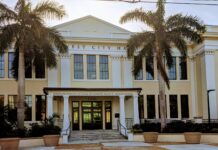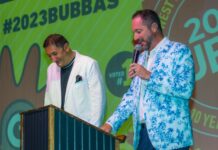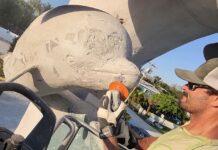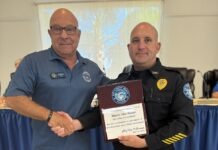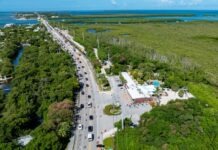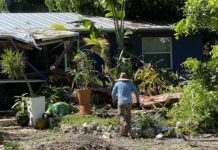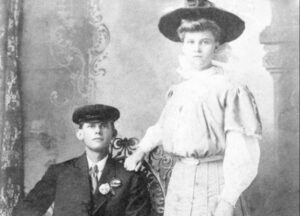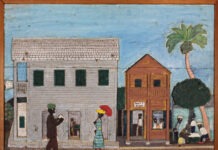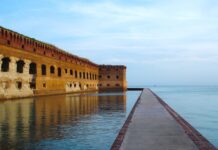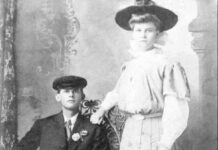In 1879, Richter Clyde Perky was born to parents living in Denver, Colorado. The boy grew up, moved east and began dealing in the South Florida and Florida Keys real estate market.
If his name sounds familiar, Perky was also associated with one of the island chain’s more unusual roadside attractions.
Richer Clyde Perky settled in Miami, and by 1914, his Island Holding Company was buying up real estate. In 1924, in the Florida Keys alone, Perky and the Island Holding Company had accumulated 25,000 acres of land that included more than 50 islands. On Key Largo, the company owned a reported 10,000 acres, about half of the total acreage of the largest of the Florida Keys. A large tract on North Key Largo was named Perkyland and included grapefruit and lime groves.
It was in the Lower Keys, on Sugarloaf Key, where Perky really left a footprint. The parcel, purchased in the 1920s, included the land previously owned by Key West’s Dr. Harris and later sold to the Chase brothers, who developed their Florida Keys Sponge and Fruit Company. Harris and the Chase brothers shared a desire to establish a commercial sponge “farming” industry in the clear shallows offshore — both failed for different reasons. When Perky bought the property, he, too, is said to have dabbled in the idea of commercial sponge farming.
R.C. Perky had big plans for Sugarloaf Key and envisioned a luxurious Florida Keys retreat in the area of what is today Mile Marker 17. He hired Fred L. Johnson to manage the property and the sponges. Johnson was from Key West and supervised the construction of Sugarloaf Key’s most memorable structure — the aforementioned future roadside attraction.
When considering his plan to develop the property, one concern was those blood-thirsty needle-toothed monsters known as mosquitoes. Perky had an idea. He had read about Dr. Charles Campbell of San Antonio, Texas, who wrote a book called “Bats, Mosquitoes, and Dollars.” One thing the book did was detail the vital role that bats can play in controlling mosquito populations. The book also promoted a bat tower of the doctor’s design capable of providing a welcoming home for a colony. He sent away for the blueprints.

Perky apparently claimed that between the cost of the plans, the lumber and the labor, he spent $10,000. According to an interview published in the Jan. 2, 1985 edition of the Miami Herald, Fred Johnson, who supervised the two carpenters who built the 30-foot tower, said the five-month project was cheaper to build — he did not say how much cheaper.
When the bat tower was finished, two things happened. For one, the tower was fitted with a plaque that read, “Dedicated to good health at Perky, Fla., by Mr. and Mrs. R.C. Perky, March 15, 1929.” The other was that Perky sent Dr. Campbell $500 for a shipment of his special “bat bait.”
When Dr. Campbell’s shipment arrived, the bait was placed on the floor of the 30-foot tall tower. The bait was a mixture of bat guano (poop) and Campbell’s secret blend of additional ingredients. According to Johnson, the stench, and it was smelly, never attracted any local bats. Perhaps the local bats preferred the fresh ocean breezes and did not care for the smell of Dr. Campbell’s special blend. Before Perky was able to purchase a second batch of the doctor’s bat bait, Campbell died and with him the recipe.
Despite the failure of the tower to attract bats, nearly a decade after it was dedicated, Perky’s luxury stop “twenty miles or thirty minutes from Key West” was being advertised in the March 11, 1939 edition of the Key West Citizen. “The Old Established Village name Perky, Florida – owning its own water, electric and other utilities and with its many fine buildings and docks, post office, telephone, telegraph, etc. Heretofore the 5,000 acre Perky Estate now at long last is open to a discriminating public. The Tavern, with its handsome, new Sugar Loaf Room for dining, ready with food that is the best. See the lights of Key West from our Observation Tower.”
Advertising being what it is, the Perky Estate boasting 5,000 acres is interesting as Sugarloaf Key, where his fine buildings and tavern were located, totals out at about 14 acres. What is clear is that the Sugarloaf Key property was not his only one in the Lower Keys. To this point, there was an interesting letter published in the October 13, 1938 edition of the Key West Citizen.
W. Curry Harris, the legal advisor to the Board of County Commissioners, Monroe County, Florida, wrote it. In part, it read: “At a special meeting of the Board of County Commissioners held yesterday afternoon, I was instructed to prepare and forward to you for your consideration, deeds for that portion of the abandoned right of way of the Florida East Coast Railway owned and held by your various companies between Big Pine Key and Key West… As near as I can figure from the right of way maps which were loaned me by the State Department, there is approximately 13,800 linear feet involved (approximately 2.6 miles). This is simply my estimate and the true figures may actually be less or greater. I hope that you will find it possible to give the county this property … I realize that you have had difficulties with the State Road Department, but in the final analysis Monroe County, and not the State Road Department, will be the beneficiary upon the completion of the new highway.”
When the third incarnation of the Overseas Highway opened in 1944, it incorporated Perky’s land donation. As for the roadside attraction, Perky’s Bat Tower fell in 2017. After nearly 90 years, the boards that once held the failed roost together were knocked about by the 130 mph winds of the Category 4 Hurricane Irma. The boards have since been removed and, in the best world possible, have been repurposed and now decorate the island chain in some alternative designs.
